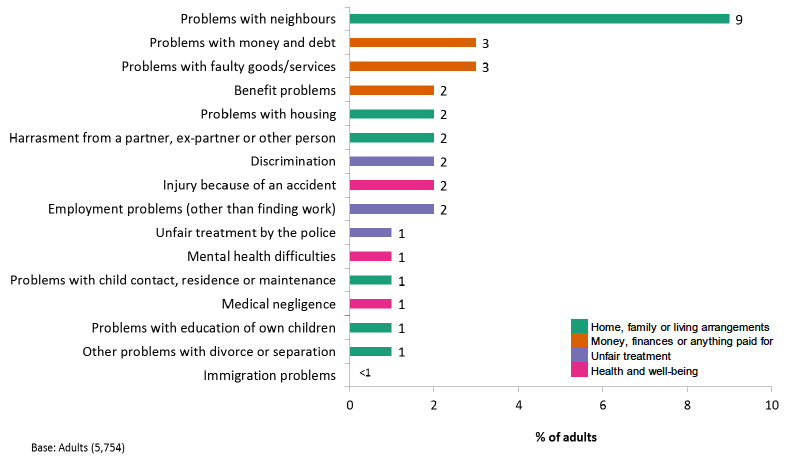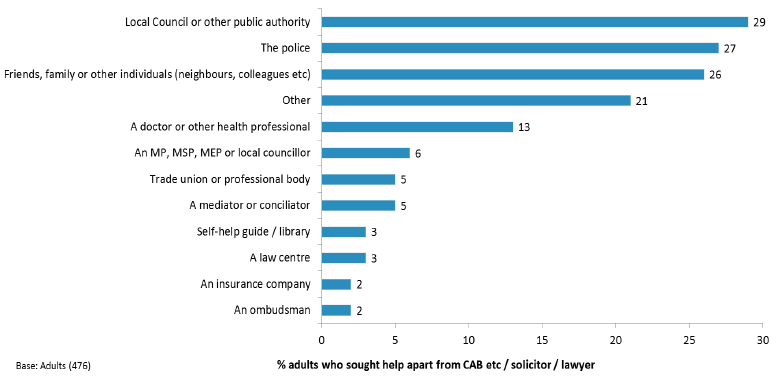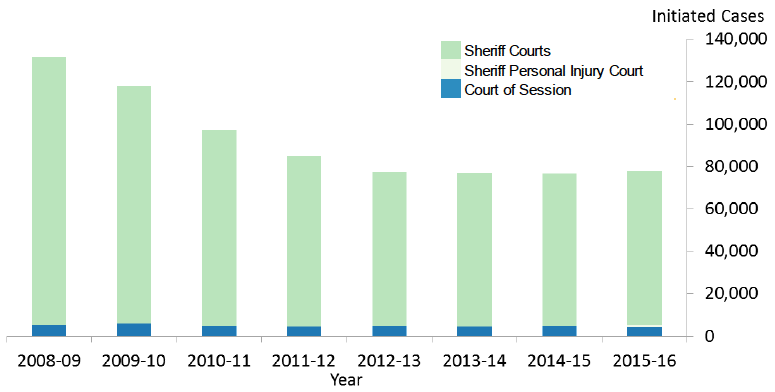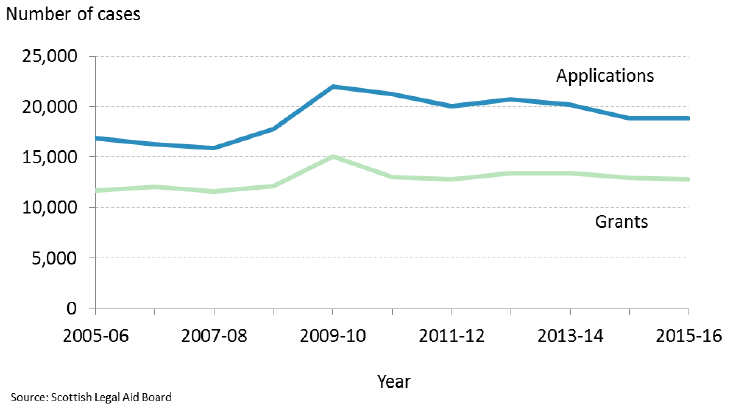Civil justice statistics in Scotland: 2015-2016
Statistics on civil justice, which aims to resolve a range of disputes from debt and eviction to divorce.
4. Recent trends in civil justice
There were 77,721 civil law cases initiated in 2015-16, a similar number to the previous three years
93% of civil law cases were raised in the sheriff courts (excluding Sheriff Personal Injury Court), and 37% of these were small claims
Most civil legal aid grants were made for cases related to family issues
Data from the 2014-15 Scottish Crime and Justice Survey shows that civil law problems are experienced by around one in five of the adult population
Scottish Crime and Justice Survey - civil justice module
The Scottish Crime and Justice Survey ( SCJS) [5] includes questions on experience of and response to civil law problems. In 2014-15, respondents were asked if they had experienced any of a list [6] of named problems or disputes in the three years prior to interview [7] . They were then asked whether they had attempted to solve them, if they had used help or advice in that process and if so, from whom.
The problem areas covered were:
- home, family or living arrangements
- money, finances or anything paid for
- unfair treatment
- health and well-being
The 2014-15 SCJS shows that around one in five adults (21%) had experienced at least one of the civil law problems asked about in the last three years. In the 2008-09 SCJS, that proportion was 30%. This nine percentage point decrease from 2008-09 to 2014-15 is statistically significant.
Among the problem areas listed above, 14% of adults had experienced problems with home, family or living arrangements, 7% had experienced problems with money, finances or anything they had paid for, 4% had been treated unfairly in some respect and 4% had experienced health or well-being problems.
The most common single problem was with neighbours, experienced by 9% of adults. The next most common civil law problems involved money & debt (3%) or faulty goods or services (3%). A more detailed breakdown is shown in Figure 3.
Figure 3: Experience of civil law problems: SCJS 2014-15

Over a third (34%) of all respondents with one or more civil law problem in the last three years said a problem concerning neighbours was their most important or only problem to solve. The next most important problems involved money and debt (8%) or faulty goods or services (8%).
Of those who identified their most important or only problem, 30% reported the problem began less than 12 months ago, 16% over a year but less than two years ago, 34% over three years ago; 20% of respondents did not know when the issue started.
Those who had experienced a problem were also asked about the current situation of their most important problem. Around half (49%) had resolved the problem, while just under a third (32%) were still trying to resolve the problem. Around one in ten had tried to resolve the problem but had to give up (9%) or were not planning to do anything (9%). Of those not planning to do anything, 54% felt it was not worth the effort and 23% did not think anything could be done.
Of those who had resolved their problem, 20% said it had taken less than a month, and 28% between one and six months.
Of those who had identified their most important or only problem, 21% had contacted or planned to contact a Citizens Advice Bureau (or a similar advice organisation) and 19% a solicitor or lawyer. Of those who had not contacted and did not plan to contact a Citizens Advice Bureau (or similar advice organisation), over a third (36%) felt able to deal with the problem without their help, a quarter (25%) did not think they could do anything to help, and 14% did not know these organisations dealt with the sort of problem they had experienced.
Those who had not contacted and did not plan to contact a solicitor or lawyer gave similar responses: a third (33%) felt able to deal with the problem without their help and 14% did not think they could do anything to help. In addition, 17% did not think the problem was serious enough to involve a solicitor or lawyer, and 16% were worried about the cost or did not want to pay the cost.
Of all respondents who identified their most important or only problem, 38% sought information, advice or help from sources other than a Citizens Advice Bureau (or similar advice organisation), solicitor or lawyer. These other sources of help are detailed in Figure 4.
Figure 4: Other sources of help or advice, SCJS 2014-15

Respondents who sought help from a Citizens Advice Bureau (or similar organisation) received advice (57%), information (56%) and/or had the organisation contact the other party on their behalf (25%). Those who sought help from a solicitor or lawyer received advice (59%), had them contact the other party on their behalf (47%) and/or received information (33%), while less than a quarter (23%) received help with threatened legal action and 22% received representation in court or in a tribunal.
Various vulnerable groups were more likely to experience civil law problems than the general population. For example, those who lived in one of the top 15% most deprived areas in Scotland suffered a higher prevalence of civil justice problems (32%) than those who did not (19%), as did victims of crime (35%) compared to non-victims (19%). Those who lived in rented (as opposed to owner-occupied) accommodation were also more likely to have experienced civil law problems: 31% for social tenants and 23% for private tenants as opposed to 18% for owner-occupiers.
Courts statistics - overview
There were 77,721 civil law cases initiated across the Court of Session, sheriff courts and Sheriff Personal Injury Court in 2015-16 (not including summary applications) ( Table 1). This is a 1% rise from the previous year, but is still 41% lower than in 2008-09. The number of cases initiated in 2015-16 was similar to the previous three years, halting the downward trend observed over the preceding years ( Figure 5).
Figure 5: Civil law cases initiated in Court of Session, sheriff courts and Sheriff Personal Injury Court

There were 70,809 disposals of civil law cases in 2015-16 ( Table 1). This is similar to the number of cases disposed of in 2014-15 but 39% lower than in 2008-09. As one expects, the trends in initiations and disposals are similar.
The year-on-year change in case numbers was not consistent across courts, sheriffdoms or case types in 2015-16. The number of cases initiated in the Court of Session decreased by 16% ( Table 2), while cases in the sheriff courts increased by 1% ( Table 3). There was also variation within sheriffdoms, as some handled fewer cases and others more, compared to the previous year ( Table 4). The case type mix has also changed with an increase in debt and eviction cases but a drop in family, personal injury, damages and (particularly) repossession cases.
Debt makes up the largest category (45%) of civil law cases handled by the courts in Scotland ( Table 11). Eviction ( Table 22) and family ( Table 5) make up the next largest categories followed by personal injury ( Table 13), damages ( Table 18) and repossession ( Table 20).
There have been 1,143 personal injury cases initiated in the Sheriff Personal Injury Court since its establishment on 22 September 2015 ( Table 1). More information can be found in the Courts Reform section.
Court of Session
There were 4,358 cases initiated in the Court of Session in 2015-16, a 16% decrease since 2014-15, and the lowest number of initiated cases since 2008-09. In 2015-16, 4,405 cases were disposed of ( Table 2).
The Sheriff Personal Injury Court was established on 22 September 2015. On the same date, the minimum value of actions that can be raised in the Court of Session was raised from £5,000 to £100,000 (see Courts Reform section for more information). These measures are expected to change the make-up of case types in the Court of Session; in particular, the majority of personal injury cases that would have previously been raised in the Court of Session are expected to instead be raised in the Sheriff Personal Injury Court (although those cases may also be raised in local sheriff courts). The statistics presented in this bulletin indeed show a 30% decrease in the number of personal injury cases initiated in the General Department in 2015-16 compared to 2014-15 ( Table 14, Civil Justice Statistics in Scotland 2014-15 Table 14), driving the aforementioned overall decrease in the number of cases initiated in the Court of Session. Personal injury cases still make up 72% of civil law cases initiated in the General Department of the Court of Session in 2015-16 ( Table 2, Table 14), down from 79% in 2014-15 ( Table 2, Civil Justice Statistics in Scotland 2014-15 Table 14).
The Court of Session also deals with judicial review. This is a specialised type of court procedure that can be used in Scotland to challenge the way a person or body with power or authority has made a decision. There were 496 judicial review cases initiated in 2015-16, a 24% rise since 2014-15 and a fourth consecutive yearly increase ( Table 24). Court actions for judicial review cover a range of different matters including planning permission and environmental cases. However, the majority of judicial review cases relate to immigration.
Sheriff courts
In 2015-16, there were 72,220 civil law cases initiated and 66,232 cases disposed of in the sheriff courts ( Table 3). While the number of cases initiated and disposed of were similar to the previous year, they have decreased by 43% and 41% respectively since 2008-09. This fall was relatively evenly spread between ordinary cause, summary cause and small claims procedures.
All sheriffdoms in Scotland have seen an overall drop in the number of cases initiated and disposed of since 2008-09 ( Table 4). Between 2014-15 and 2015-16, Lothian and Borders sheriffdom saw the largest decrease in initiated cases (-4%), with Tayside, Central and Fife sheriffdom and Grampian, Highlands and Islands sheriffdom both recording 2% fewer cases. South Strathclyde, Dumfries and Galloway sheriffdom saw the largest rise in initiated cases (+9%), Glasgow and Strathkelvin sheriffdom saw a 4% increase, and North Strathclyde sheriffdom a 2% increase. The South Strathclyde, Dumfries and Galloway sheriffdom recorded the highest number of sheriff court cases initiated in 2015-16.
The National Records of Scotland mid-2015 population estimates were used to create population estimates for each sheriffdom ( Supplementary Table S13). These estimates were then used to calculate the number of cases initiated and disposed of per 1,000 population. This allows direct comparison of the incidence of civil law cases in each sheriffdom. The overall number of cases initiated across Scotland was 13 for every 1,000 people in 2015-16 ( Table 4). This rate is broadly similar across all sheriffdoms, with Glasgow and Strathkelvin, and South Strathclyde, Dumfries and Galloway sheriffdoms having the highest rate (16 for every 1,000 people).
There was a large variation in the number of civil law cases dealt with by individual sheriff courts in Scotland in 2015-16 ( Supplementary Table S1). The number of cases handled by Glasgow sheriff court increased compared to the previous year and still had by far the largest number of cases initiated (11,853 cases), followed by Edinburgh sheriff court (8,783 cases). Courts in the more rural parts of Scotland dealt with far fewer cases, with Lochmaddy having the lowest number of cases initiated in 2015-16 (58 cases). A map showing the location of sheriff courts in Scotland, together with information on recent court closures, is shown in Figure 15.
In addition to civil law cases concerned with disputes, sheriff courts also deal with commissary business, which relates to succession and access to a deceased person's estate. In 2015-16, 22,984 ordinary estates were confirmed with an average value of £239,000 ( Supplementary Table S6). There were also 2,129 small estates confirmed, with an average value of £23,100.
Civil law legal aid
The Scottish Legal Aid Board ( SLAB) administers legal aid, which is paid for out of public funds and helps towards the costs of legal advice and representation for those who qualify. It is designed to help individuals who would be unable to pay on their own to gain access to the legal system. In 2015-16, civil legal assistance made up around a third of the net total legal assistance expenditure in Scotland (the other two thirds being criminal legal assistance).
There are two main types of civil legal assistance: advice and assistance (including assistance by way of representation) and civil legal aid. Advice and assistance helps pay for advice from a solicitor on any matter of Scots law. Civil legal aid helps pay for a solicitor to take the case to court. Civil legal aid makes up around 16% of the number of grants of civil legal assistance. However, as civil legal aid cases cost more than other types of civil legal assistance, net expenditure on civil legal aid makes up more than half of the total expenditure on civil legal assistance. Demand for and expenditure on civil legal aid has decreased in recent years. Figure 6 shows that demand (as measured by applications) peaked in 2009-10 following rises in the previous two years.
In 2015-16, there were 12,817 civil legal aid grants, the vast majority of which for cases in the sheriff courts. After steadily rising for over 10 years, legal aid grants in relation to intervention orders and guardianship orders under Part 6 of the Adults with Incapacity (Scotland) Act 2000 now represent the largest category of legal aid certificates issued, at 32% of all grants. The next largest category is contact/parentage, which accounted for 21% of all grants in 2015-16.
SLAB manages three grant funded programmes which include 102 different projects across Scotland to enable support for people affected by repossession, eviction, debt problems and benefits disputes. In 2015-16 these programmes enabled 26,925 people to access help, including representation at court or tribunal for 4,880 people.
Further information and data on legal aid is available from the Scottish Legal Aid Board Annual Report 2015-16.
Figure 6: Civil legal aid applications and grants

1. Applications and grants may not relate to the same cases because of the interval between an application and a decision to grant. Also note that granted cases may not always proceed.
Contact
Email: Jeremy Darot
There is a problem
Thanks for your feedback